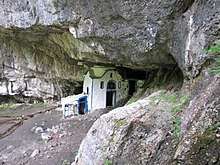Agios Dionysios Monastery, Olympus

The Monastery of Agios Dionysios in Olympus (Greek: Μονή Αγίου Διονυσίου εν Ολύμπω) is a Greek Orthodox monastery on the slopes of Mount Olympus, the most important monastery in the Pieria Prefecture. It is located at the Enipeas ravine at an altitude of 850 m (40°05′38″N 22°25′44″E / 40.094°N 22.429°E) The original monastery was established in 1542, was destroyed by the Germans in 1943. A new monastery was established at a distance of some 5 km to the northeast of the old one, closer to the town of Litochoro. (40°07′05″N 22°29′02″E / 40.118°N 22.484°E) . The Agios Dionysios Monastery is a stauropegic monastery, subordinated directly to the Patriarch of Constantinople (Istanbul).
Beside the monasteries Kanalon and Agia Triada, Sparmos it is one of the monasteries located at Mount Olympus.
Name
Originally the name of the ancient monastery was Agia Triada, Holy Trinity, (Greek Αγία Τριάδα).[1] In the course of time, however, the name of its founder, Saint Dionysius of Olympus , has prevailed. The new monastery was named directly after Saint Dionysius.[2]
Old Monastery
The old monastery was founded and devoted to the Holy Trinity by Saint Dionysius in 1542. Surrounded by strong high walls and towered by a watchtower, it resembles a small fortress. During various conflicts it served as a shelter for civilians, but also for fighting troops. Today the visitor can see a ruin from the outside. In its history the monastery has been destroyed and rebuilt several times. It was destroyed in 1821 by Veli Pasha and again by the German Wehrmacht in April 1943. Assuming that the building might serve as a refuge for Greek resistance fighters, the Germans first bombed it and later demolished it with explosives.
The chapel of Saint Dionysios

Twenty minutes' walk from the old monastery is the chapel of Saint Dionysius. It is located at the Enipeas River in a southeastern direction from the monastery. Who from Litochoro ascends to Prionia comes necessarily by the chapel. It is built under an overhanging rock, just above a spring. It consists of a small devotional space where the saint celebrated the sacred liturgy during his time as a hermit. A small shed served him as a sleeping place.
New Monastery

The monks abandoned the destroyed monastery and moved into the Metochion, the estate of the monastery. The Metochion was founded in 1650 and consisted, apart from the lands, of a church, the economic buildings and another building in which the monks lived, who took care of the farm.
After the Second World War, this estate was gradually expanded into a monastery. The older part of the new monastery is equipped with a heavy iron door and thus separated from the rest of the system. It contains the cells of the monks, the refectory and the administrative building. As is usual with Greek Orthodox monasteries, the this part of the building is subject to the abaton ("inaccessible") rule, prohibiting access to female visitors. Just outside are the stables, workshops and the cheese factory. All buildings outside the abaton, such as the new church or the museum, were built after 1985.
The church
The monastery church was built in classical orthodox style. An image of Saint Dionysius adorns the entrance. Inside, in addition to the usual sumptuous decor of an Orthodox church, there are some special features. It is striking that many chairs, standing consoles and other items are decorated with marquetry. The inserts are made of ivory or mother-of-pearl. On a small table stands an icon depicting the resurrection of Jesus Christ. Next to it is a little basket with notes and ball-point pens. Believers who want to make a request to the saint can put it here on paper.
The museum
To the west of the complex is the museum. In troubled times, of which the old monastery lived some, monks were hiding the monastic treasures in secret vaults. A selection of rescued exhibits:
- Three silver skulls, into which bone pieces of saints were worked, are exhibited together with other relics.
- Old documents, including the document from the year 949 of the Islamic calendar (1542 AD), in which the Ottoman occupiers allow the repair (in fact probably the foundation) of a monastery on Mount Olympus.
- Through a magnifying glass one can admire the finest wood carvings within a metal cross.
- A epitaph, embroidered with gold threads, made in the years 1578 and -79 by Arsenius, a monk of the Meteora Monasteries.
- Some of the rescued icons of the old monastery.
Quite inconspicuous, but significant, some framed black-and-white photographs hang near the entrance. They show the old monastery in the mountains just before its destruction. A soldier of the Wehrmacht made these pictures secretly and sent them to the monastery a few years ago.
Literature
- Holy Patriarchal and Stavropegic Monastery of St. Dionysios of Olympus: I Iera Patriarchiki ke Stavropigiaki Moni tou Agiou Dionysiou tou en Olymbou. Publisher: Holy Patriarchal and Stavropegic Monastery of St. Dionysios of Olympus, 2014